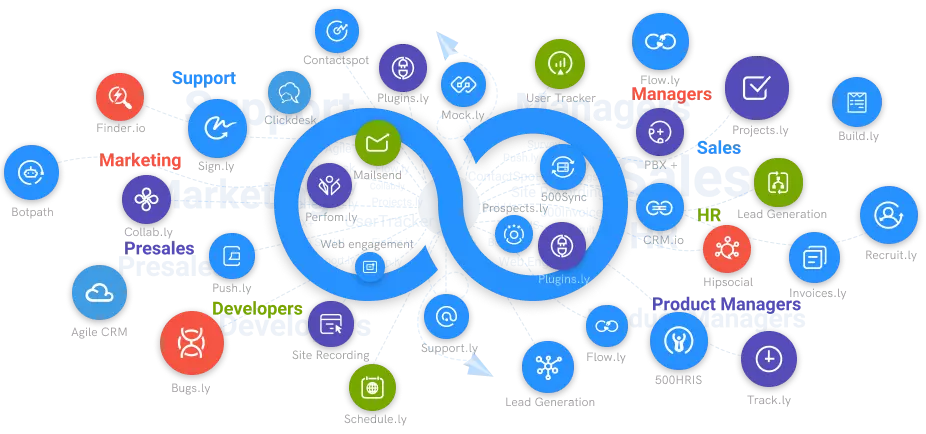Why to Use Behavioral Segmentation in Push Marketing?
Let us gather idea about behavioral segmentaion of users in push marketing and what is the importance of demographic data of users for the same.
#1
Access Multiple Websites
#2
Drip Sequence Automation
#3
Create messages, notifications, reminders using built-in templates
#4
Increased Visitor Traffic
#5
Effective Audience Classification
#6
Scheduled and Automated Messages
#7
Extensive Data Analysis
#8
Affordable Pricing
#9
Unbelievable pricing - the lowest you will ever find
#10
Everything your business needs - 50 apps, 24/5 support and 99.95% uptime
Behavioral segmentation in push marketing, as the name suggests, is a way of categorizing clients based on their behavior patterns. These behaviors may be associated with the customer lifecycle, such as getting married, having a baby, or purchasing a home, or with seasonal trends, such as Christmas shopping and summer vacations. Customers' interactions with your business, such as their purchase history or how they responded to certain push marketing messages, may also be segmented. Marketers and data science teams typically utilize behavioral segmentation factors in conjunction with traditional demographic and geographic data to improve the effectiveness of their offerings and communications. In order to evaluate their techniques or predictive models, they will look for connections between particular behavioral data and demographic categories such as age, income, and geography.
Why Behavioral Segmentation of Consumer is Important?
With today's abundance of consumer data, companies may segment their audiences in a variety of ways, including demographics, psychographics, and behavior. Behavioral segmentation in marketing is one of the most efficient strategies for identifying and removing roadblocks throughout the customer journey. Marketers may improve the effectiveness of their push marketing by measuring the consumer behaviors that are most relevant to their unique product or service. Online merchants, for example, may opt to track every product and link consumers to click on their eCommerce website, whereas a media firm may choose to measure how long users spend reading articles or what content categories people share most frequently.
Segmentation in push marketing has always been essential. Despite this, just 33% of firms who use it think it has a major impact. One major issue is that many businesses rely entirely on traditional techniques, such as regional and demographic segmentation. There's no disputing that understanding your typical customer's location, age, gender, and so on is critical to meeting their demands. But simply realizing who they are isn't enough. You must also understand what they do, thus utilizing additional consumer data, such as behavioral data, is essential. Other segmentation data you've gathered may be rendered ineffective if you don't have this. Segmenting users help in providing what exactly your target customers want and there is a higher chances in increasing customer retention.
What is Demographic Data of Consumers?
Demographic data refers to socioeconomic statistics such as population, race, income, education, and employment, which reflect distinct geographic regions and are frequently connected with time. When it comes to population demographic statistics, for example, we have characteristics such as area population, population growth or birth rate, ethnicity, density, and dispersion. In terms of employment, we have employment and unemployment rates, which may be further subdivided by gender and ethnicity. Census agencies, both government and commercial, frequently collect demographic data, which is then used for research, marketing, and environmental and human development.
The government can utilize statistics such as population and employment, as well as all associated data fields such as density, ethnicity, and gender, to plan for infrastructure development such as roads, hospitals, and law enforcement. Marketers and corporate organizations also utilize demographic data for customized advertising and product distribution. Fast food outlets, for example, frequently serve Mexican-themed meals rather than Mediterranean ones in locations with a high Latino population density. Branches of well-known American fast-food corporations in foreign nations frequently adapt their menus to local tastes. All of them are the result of a demographic study based on population data.
Importance of Demographic Data
Demographic data is essential for understanding how people seek information and buy products and services online. Income and cultural variables, for example, may influence how your target client or consumer uses technology. Do they have access to smartphones and tablets to search for your company? Where do they call home? Because of the speed and coverage of the internet in their region, the actual location of your clients or consumers may be influenced. These are only a few instances of how demographics may affect your internet company. Demographics are also significant since they are quantifiable qualities. For example, it is simple to determine how many individuals are between the ages of 18 and 24, as well as how many people dwell in a city or town. Being able to quantify such traits helps you to determine the number of people to whom you might possibly market your products or services.
Demographic data is a statistical representation of socioeconomic information such as employment, education, income, marriage rates, birth and death rates, and so on. Demographics are used by governments, companies, and non-governmental organizations to learn more about the characteristics of a population for a variety of reasons, including policy formation and economic market research. The internet, social media, prediction algorithms, and big data have had a profound impact on the collection and use of demographic information. Modern customers inadvertently give out a torrent of data that is gathered and monitored via their online and offline lives by a plethora of applications, social media platforms, third-party data collectors, merchants, and financial transaction processors. Demographic data is gathered for corporate marketing purposes in order to create a client base profile. Age, gender, income level, race, occupation, location, homeownership, and level of education are all typical characteristics obtained in demographic research. To identify clients, demographic information is used to create assumptions about groups. Other demographic aspects include obtaining information on interests, hobbies, lifestyle, and so on. When conducting a national census, government organizations collect data and may utilize that demographic data to anticipate economic patterns and population growth in order to better manage resources.
Conclusion
Today's businesses rely heavily on demographics. They aid in the identification of specific members of an audience by choosing essential qualities, desires, and requirements. This enables businesses to target their efforts to certain groups of their consumer base. Over the last decade, online advertising and push marketing have made great strides in leveraging algorithms and big data analysis to micro-target ads on social media to extremely precise demographics. Behavioral segmentation, like the other forms of marketing segmentation, helps you better understand who your target client is. The better you know and understand a consumer, the more personal the value proposition you can provide, and the more likely your offer will resonate with them and persuade them to buy.
Our push notification software, PushNinja, provides you with the best behavioral segmentation feature to send perzonalized push notification to your target customers at the right time at the right place and with the right message.





